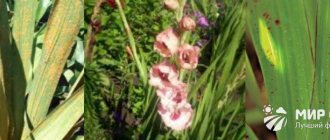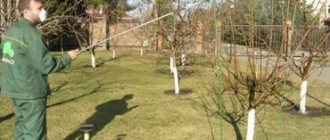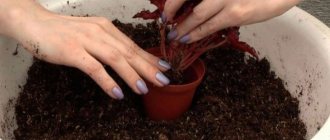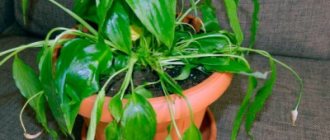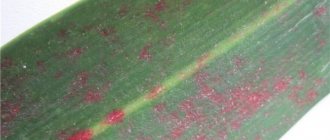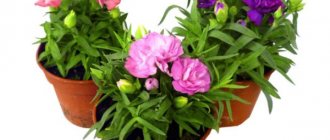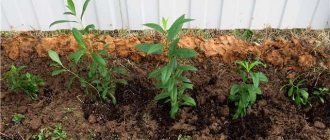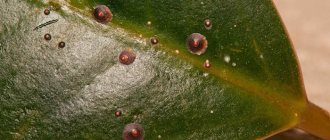One of the most attractive indoor plants for amateur gardeners in our country is cyclamen. An original plant with beautiful flowers has long and firmly taken its place on the windowsills of many apartments and has become a source of pride for their owners. However, this plant needs special attention, and responds to improper care with the appearance of various diseases that can negate all efforts to grow them. The only way to avoid cyclamen disease is to surround them with attention and provide proper care.
Description of the plant
Cyclamen is a herbaceous perennial with a tuberous thickened root. Perhaps it was due to the shape of its roots that it got its name. It grows naturally in the Mediterranean regions, but is better known as a houseplant.
This small, elegant flower with an interesting pattern on the leaves is valued for its high decorative properties. Its single flowers on long tall peduncles are distinguished by a variety of colors. While at first there were only species with red and white flowers, breeding has now produced varieties with different shades of pink, lilac and pale purple. The most common indoor flower is Persian cyclamen.
A distinctive feature of cyclamens is the fact that they bloom in the winter - from October to March.
The main causes of cyclamen diseases
All diseases of cyclamen occur, as a rule, due to non-compliance with the conditions of their maintenance. The main causes of diseases are:
- low air humidity;
- excessive watering;
- temperature violation;
- incorrect soil composition;
- improper care during the rest period;
- lack of lighting during the period of active growth and flowering.
Preventing cyclamen diseases is much easier than treating them. Therefore, the plant must be regularly inspected and, when the slightest signs of disease appear, promptly respond to them by adjusting the conditions of detention.
Known diseases and treatments for cyclamen
Often flower lovers fall in love with a plant so much that they cause irreparable harm to it. Sometimes they simply don’t know the basic rules of care. Factors causing diseases:
- Very dry air in the room, low humidity.
- Constant waterlogging of the soil in the flowerpot (perhaps the flower is in a damp and poorly ventilated area). A huge mistake is to flood the plant during the dormant period.
- The temperature in the room is too high (heat is very poorly tolerated by cyclamen).
- An unsuitable soil mixture can cause disease.
- The other extreme is the complete absence of sunlight. All plants need sun. Without the process of photosynthesis, development is impossible, so you should definitely give cyclamen a small amount of soft, diffused light.
This is a list of just some of the reasons when a flower begins to act up and sometimes dies. Before growing, it is recommended that you familiarize yourself with the basic rules so that the plant is well-groomed and receives all the necessary care. In most cases, the disease can be detected at the very beginning and successfully treated.
Fusarium (fusarium wilt, dry rot)
- The disease is characterized by a gradual yellowing of the upper part of the flower. At the same time, the second part continues to grow and develop.
- The outbreak is considered to be a fungus called Fusarium. It penetrates the plant tissue, causing the blood vessels to become clogged. As a result, parts of the flower stop receiving the necessary nutrients and begin to die.
- The danger lies in the fact that the spores of this fungus remain in the soil for a fairly long period and continue to penetrate the roots and young shoots. If you make a cut, you can see the affected bundles of blood vessels on the tissues of the tuber.
Maintenance during the rest period
In nature, active growth and flowering of cyclamens occurs in winter, which is characterized by cool weather and heavy rainfall. The plant perceives an increase in temperature as a signal of the onset of a hot, dry summer and begins to prepare for it. This feature is one of the reasons why problems arise with the content of cyclamens. In an excessively warm room, they stop blooming and try to shed their leaves, preparing for a dormant period. This fact must be taken into account when caring for a flower. Proper alternation of periods of growth with periods of rest and the creation of appropriate conditions during these periods will avoid many problems associated with cyclamen diseases and their treatment.
Rules of care
Cyclamen diseases will bypass you if the flower is provided with the following conditions:
- Correct lighting. During the active period, it should be bright, but exclude direct sunlight from entering the plant. Therefore, it is better to keep the flower in partial shade on windowsills facing east and west. On southern windows the plant will have to be shaded, and on northern windows there will be too little light for it.
- Temperature. In winter, during the period of active growth and flowering, the optimal temperature for cyclamens is +10 °C, the maximum limit is +14 °C. In summer, the ambient temperature should not exceed 25 °C. If possible, it is recommended to bury the pot with the plant in the garden, in a shaded place.
- Watering. It will require soft, settled water, the temperature of which should be a couple of degrees below room temperature. During the flowering period, the plant is watered so as to prevent the earthen clod from drying out or becoming waterlogged. Top watering is possible if it is done carefully so as not to soak the buds and tubers. It is better to water cyclamen from a tray. After holding the pot in the pan for one or two hours, drain the water from it to prevent rotting of the roots. When flowering ends, watering is gradually reduced, and with the onset of the summer dormant period, watering is extremely rare. From the beginning of autumn, watering is gradually increased.
- Air humidity. To increase it, the plant is periodically sprayed until the buds appear, after which the spraying is stopped so that the buds do not rot. To humidify the air, the pots can be placed on a tray with damp moss, expanded clay or pebbles so that their bottom does not touch the water.
- Feeding. When the plant is actively growing leaf mass and right up to the beginning of flowering, it is fed every two weeks with full mineral fertilizer. It must be remembered that an excess of nitrogen fertilizers can lead to rotting of the roots.
- The soil. Cyclamens should be replanted in soil consisting of leaf soil, humus, peat and sand. Soil acidity should not be higher than six, otherwise the likelihood of developing various fungal diseases increases.
Failure to follow these basic rules leads to various problems. Let's look at the main diseases of cyclamen with photos.
Prevention
It is quite difficult to treat diseased cyclamens. Experts note that preventive measures help to significantly reduce the risk of flowers being damaged by various pests. It is recommended to follow them immediately after purchasing cyclamen. For good growth, the flower requires optimal air temperature, as well as moderate watering. There are a few tips worth paying attention to.
- To detect any damage to the flower in time, it must be inspected regularly. In this case, special attention should be paid to foliage. Leaves must be inspected not only from the top side, but also from the bottom. If necessary, you can use a magnifying glass. This will allow you to detect even the most minor changes, which means that treatment can be started on time if necessary.
- Before planting cyclamen in the substrate, it is recommended to treat the soil. For this purpose, it is sterilized or steamed. Some experts recommend treating the substrate with a weak solution of potassium permanganate.
- In order for cyclamen to grow well, the nutrient substrate in which it is located should not be fertilized too much. Thus, the abuse of nitrogen fertilizers can cause damage to the root apparatus of the flower, which means it can lead to slower growth.
- Choosing the optimal size pot is very important. These decorative flowers generally grow well in medium-sized containers. Experts recommend choosing a pot for this beautiful flower in such a way that the distance between its corm and the wall of the pot is approximately 2.5–3 cm. It is better to place the pot with the plant away from heating appliances.
You can learn how to properly transplant cyclamen by watching the video below.
Rot
The most common diseases of cyclamen are various types of rot.
- Wet rot. Flowers and leaves droop, and an unpleasant putrid odor appears. The roots also gradually rot. The cause of the disease is infection getting into cracks or wounds on the plant. The source of infection is a diseased plant or contaminated water. Unfortunately, in this case it will no longer be possible to save the flower. It must be destroyed to prevent infection of other plants. Preventive measures - compliance with the irrigation regime, avoiding waterlogging of the soil.
- Gray rot. The plant becomes soft and watery, and a gray moldy coating forms on it. The disease is provoked by high humidity levels and too low temperatures. To combat the disease, remove all diseased leaves and flowers and treat the plant with a fungicide. Make sure that the air is dry, to this end, ventilate the room, avoiding drafts. To avoid the appearance of gray rot, you need to prevent excess moisture and water from getting on the tuber and leaves during watering.
- Non-infectious rot of tubers causes yellowing and wilting of the leaves. The tubers become brown and soft. The diseased plant is destroyed. As a preventive measure, you need to use the right soil mixture, follow the feeding rules, moisten the tubers less often, especially in the heat, and do not plant them at great depth.
Let's look at other fungal diseases of cyclamen and their treatment with photos.
Why doesn't cyclamen bloom?
Despite the fact that the plant has very beautiful and decorative leaves, their color and shape are not the main decoration of the bush.
Still, cyclamen is grown for its lovely butterfly flowers, and it’s a shame when they don’t want to appear. The reason for the lack of flowering in cyclamen may be the following factors:
- low level of indoor humidity;
- poor watering;
- high temperature (he doesn’t like this);
- pot too spacious;
- the corm is completely buried in the soil (in varieties for which this is unacceptable).
By adjusting these errors and creating comfortable living conditions for the plant, you will soon be able to see it blooming.
As you can see, we create most of the problems when growing cyclamen ourselves, without providing the plant with proper care. Fortunately, this can be corrected by promptly paying attention to the changes occurring in the flower. Surround your cyclamen with care, and it will delight you with gorgeous blooms.
Saving purchased cyclamen - video
Anthracnose
Increased temperature and humidity provoke the occurrence of this fungal disease. Outwardly it appears only with the beginning of flowering. If the flower stalks are affected by the fungus, they develop poorly, look twisted and turn yellow at the top. Buds do not appear, and existing ones do not bloom. Then the disease also invades the leaves. They turn yellow and dry out.
To save the plant, it is isolated, dried tissue is removed and treated with fungicides. Bring air humidity and room temperature in accordance with care requirements.
Diseases - description, photos, treatment tips
The plant sheds its leaves
Sometimes it’s not worth worrying about what to do if leaves and flowers have fallen from a plant. Because after the cyclamen has bloomed, it begins to prepare for the dormant period and sheds everything “excess”. It is very simple to determine this dormant period: the plant bloomed safely from September to March and dropped its flowers.
But if the shedding of leaves occurs in the middle of flowering, then it is worth reviewing the flower care points:
- lighting - there should be a lot of it, but you need to make sure that direct sunlight does not fall on the leaves;
- temperature regime - the air should warm up to a maximum of twenty degrees, but at the same time the temperature should not fall below ten degrees above zero;
- humidified air - but to maintain this condition, experts do not recommend spraying cyclamen; the best solution would be to place a container of water near the flower pot;
- hygiene - it is necessary to periodically wipe the leaves from dust, as well as promptly remove dead areas.
Silvery plaque or gray rot
This disease is caused by the fungus Botrytis cinerea. Typically, these fungi enter plants through contaminated air or water. But if normal conditions for growing cyclamen are provided, this harmful fungus will not be able to develop and will simply die.
However, when creating conditions for the development of Botrytis cinerea (high air humidity; low temperature, especially at night; too much soil moisture; improper watering, in which water gets into the growth points of leaves or buds), the flower may die, and in a very short period of time.
Symptoms of gray mold infection:
- the appearance of a silvery coating on shoots and leaf blades;
- the affected flower shoots begin to darken and die over time;
- the leaves on which mold has appeared gradually turn yellow and eventually disappear completely.
Treatment of gray rot:
- isolate the affected plant to prevent infection of neighboring flowers;
- remove already “sick” areas of cyclamen;
- ensure regular ventilation of the room, but this must be done in such a way that drafts do not form;
- reduce watering to a minimum, and completely eliminate spraying from care items;
- treat the plant with fungicides (this can be Euparen, Rovral, Ronilan).
Reference! If the disease is not detected in time, the flower is unlikely to be saved.
Fusarium
Another name is dry rot. The cause of the plant being affected by this disease is also a fungus called Fusarium. The advantage of this flower disease is that it develops quite slowly. And if you regularly inspect the flower, then there is every chance that the cyclamen will be revived.
The fungus destroys the tissues of the flower and then spreads to the vascular system, clogging the vessels of the plant. All this leads to the gradual withering of cyclamen.
Symptoms of the disease:
- leaf blades turn yellow, starting from the top of the plant;
- in this case, most often only one side is affected, while the second continues its development and flowering.
Treatment of fusarium:
- isolate the flowerpot with cyclamen;
- Spray with Topsin-M solution;
- water the soil with a solution of foundationazole.
Important! Very often, the Fusarium fungus remains in the soil, so it is better to replace it with a new one or treat the old one. This can be done by placing the soil in the microwave for a few minutes or in the freezer for a few hours.
Wet rot
The causative agents of this disease are Erwinia bacteria. Cyclamen can become infected in several ways:
- through a nearby flower;
- through contaminated water;
- through mechanical damage to different parts of the plant.
Symptoms:
- sudden wilting of leaves and flowers;
- unpleasant odor that comes from the rhizome;
- Root rotting.
There is still no really helpful way to cure a plant from wet rot. Therefore, the only correct solution would be to destroy the flower along with the soil in which it grew, so that the bacteria do not spread to other plants.
Anthracnose
The disease is caused by a fungus from the genus Gloeosporium . But the following incorrect care points are already developing anthracnose:
- too high air temperature (over 20 degrees Celsius);
- too humid air.
For a very long time, this disease may not make itself felt. Anthracnose appears only when a flower shoot appears on the plant. It grows in a crooked shape, develops poorly, and then begins to turn yellow from the top. The buds never grow and even the existing ones eventually do not bloom. Then the disease spreads to the leaf blades, which also turn yellow and dry out. This also applies to young leaves.
Treatment:
- isolate the plant;
- normalize the humidity level in the room - it should be slightly reduced;
- remove dried areas of cyclamen;
- treat with fungicidal preparations three to four times with a break of 5-7 days.
Rhizoctoniosis
Rhizoctonia rot is caused by the fungus Rhizoctonia solani JG Kuhn. Both flowers and those already formed can be influenced. cyclamens. Infecting fungi are localized in the soil and from there they infect the root system.
Good conditions for propagation of flexiweed are:
- high air temperature;
- too humidified air;
- overly active feeding with fertilizers.
Symptoms:
- the appearance of depressed pigmentation of a dark color both on the above-ground part and on the underground part of the flower (this pigmentation tends to multiply very quickly);
- At the sites of pigmentation, a fungal coating forms, which can be white or gray.
Treatment:
- to prevent the appearance of rhizoctonia rot, special attention should be paid to the choice of soil - it should allow the roots to “breathe” - and loosen the soil as often as possible;
- stop watering completely;
- replace the soil with a new one;
- treat cyclamen with fungicides (spraying).
Attention! Rhizoctonia rot spreads very quickly and kills the plant at the same rate, so you need to act immediately.
Late blight
Caused by the fungus Phytophthora. Favorable conditions for the development of this fungus are absolutely identical to those conditions that provoke the development of rhizoctonia rot, so we will not list them.
Symptoms:
- sheet plates lose their strength and tightness;
- the lower leaves and peduncles begin to dry out, followed by other parts of the plant;
- the root tuber becomes rotten.
Treatment:
- do not forget about the importance of soil quality: it must ensure air circulation;
- temporarily stop moistening the soil;
- get rid of the contaminated substrate;
- treat the affected plant with the following fungicides: Profit Gold, Ridomil, Previkur.
Fusarium leaf wilt
The disease is caused by the fungus Fusarium oxysporum Schlecht. This particular mushroom thrives in very dry soils that lack nutrients.
Important! Sudden changes in soil dryness and moisture cause the active development of the fungus Fusarium oxysporum Schlecht.
Symptoms:
- yellowing and drying of the lower leaves of cyclamen;
- damage to the root system;
- then the flower shoots also become infected.
Treatment. Fusarium wilt is very difficult to treat . In most cases, even fungicides do not help control this disease. Therefore, it is necessary to take preventive measures: carefully select the soil, avoid elevated temperatures and sudden changes in soil moisture levels.
Late blight and other fungal diseases
One of the most common diseases and pests of cyclamen is the Phytophthora fungus. Favorable conditions for its development include too high temperature and air humidity, as well as excessively active feeding with fertilizers.
Externally, the disease manifests itself as a loss of elasticity and strength of the leaf plates, which later begin to dry out. The tuber becomes rotten.
To combat late blight, you need to temporarily stop watering, completely replace the soil in the pot, treat the plant with fungicides and maintain the required temperature and humidity in the room.
Dangerous fungal diseases of cyclamen also include rhizoctonia and fusarium. Methods for treating and preventing the former are similar to the treatment of late blight. Fusarium is very difficult to treat even with fungicides. It is easier to prevent it by adjusting the conditions in which the flower is kept.
What insects like to eat cyclamen?
Another problem when growing cyclamen is pests. The juicy leaves of cyclamen attract the attention of not only gardeners, but also various insects. By establishing who exactly attacked your flower, you can help it get rid of the “uninvited guests.” This can be done using a magnifying glass or by the nature of the changes occurring in the bush.
The appearance of a cyclamen mite is easy to notice by the following signs:
- first, the leaf plates begin to lose their shape and bend ugly;
- then they stop growing and become hard;
- the inflorescences fade, and the flower stalks become deformed (curved).
Unfortunately, most often it is not possible to get rid of the insect, since conventional insecticides and fungicides do not have the desired effect on it. All that remains is to voluntarily “kill” the plant in order to avoid infecting the entire flower collection.
If thrips appears on the cyclamen, the leaves of the plant:
- first covered with white dots;
- then they merge into gray-silver spots;
- begin to curl;
- gradually die off.
To combat thrips, use Aktara or Fitoverm. At the initial stage, when there are not very many pests, drugs can help get rid of them. In case of massive damage, the flower dies.
One of the most dangerous pests of cyclamen is the scale insect, primarily for the reason that it is generally impossible to get rid of it with the help of drugs. Often gardeners do not even notice it until the flower begins to disappear. If you see convex growths on the petioles, peduncles or the back of the leaves, this is not a deformation of the plant, but a very dangerous enemy. The scale insect is covered on top with a strong semicircular shell that protects it. The insect is firmly attached to the flower, literally merging with it into one whole, and no chemicals will help here. The only way to get rid of scale insects on cyclamen is mechanically, by manually tearing them off.
To facilitate the process, before removing the pest, it must be wiped with a swab dipped in alcohol. During removal, the soil under the bush should be covered so that the scale insect does not fall into the pot.
A common “guest” on cyclamen is aphids. These small white insects suck the juices out of the leaves, as a result of which they begin to curl and deform, becoming covered with a sticky coating, and young leaves appear small and also curved.
You can free cyclamen from aphids by regularly washing the leaf blades with a solution of green or laundry soap, additionally spraying the bush with Fitoverm.
Viral diseases
Among the diseases and pests of cyclamen, photos of which are presented below, special mention should be made of viral infections:
- Leaf bronze virus manifests itself as deformation of leaf blades, a brown pattern on them and necrosis of veins and tissues. Sick plants are destroyed.
- Ring mosaic virus. The leaves develop ring patterns that resemble fingerprints. The veins harden and the leaves crack. Sick plants should be destroyed.
The carrier of this virus is thrips. To prevent infection, special sticky traps for these pests are hung in places where plants are kept. In addition to thrips, there are other pests. Cyclamen diseases and the treatment of ailments caused by them also require special attention.
Pests and their control
The most common pests of cyclamen are:
- Aphid. These insects are capable of literally sucking all the juices out of a plant in a matter of days. In large quantities, aphids cover the flower like a coating. As a result, it becomes deformed and may die. The plant should be washed under a strong stream of water and treated with an insecticide.
- Cyclamen mite. Due to its microscopic size, its appearance can only be noticed when a lot of individuals accumulate in one place. A cluster of yellow dust appears to form on the inner surface of the leaf. As a result, the leaves begin to change at the edges, the stems curl, and the buds fall off. To save the plant, you must immediately remove all its affected parts and spray it with an insecticide.
- Root root nematodes. Signs of their appearance are stunted growth and the formation of nodular swellings on the root that resemble beads. Unfortunately, such a plant must be destroyed.
Prevention of cyclamen diseases consists of proper care and compliance with all necessary maintenance requirements.
Diseases and their photos: how to recognize and what to do for treatment?
There can be quite a lot of diseases due to which this indoor flora can lose its blooming appearance and even die. They all have different symptoms and treatments, so they need to be considered separately. Also in the photo you can see what the most common cyclamen diseases look like.
Dropping leaves
Yellowing of leaves and their falling off of this plant is a fairly common problem. Most often this happens due to improper care.
Cyclamen can shed its leaves before the seasonal rest period, but then they fall off slowly and gradually.
If the cyclamen has dropped part of its leaves or almost all of its leaves, you need to know what to do to resuscitate it. To do this you need:
- Adjust the air temperature in the apartment (cyclamen loves a temperature of 12 to 17 degrees).
- Normalize watering. You need to water the flower when the top layer is almost completely dry, that is, about once a week. Find out more about how to save a flooded flower from waterlogging here.
- Protect cyclamen from direct sunlight. This plant loves diffused light.
- Fertilize the soil. This should be done with fertilizers containing nitrogen approximately once every two weeks after transplantation until the buds appear, and once a month after the buds appear.
Gray mold
Another common disease for cyclamen is gray mold, which can appear as a silvery or gray coating on the leaves .
The reason for its appearance is a fungus, the development of which occurs due to dampness and coolness in the room. Also, such rot can be a consequence of improper watering, for example, if, during watering, moisture gets into the “growing points” of buds and leaves.
This disease is indicated by the presence of the following factors:
- the presence of gray or silver mold on the leaves and stems of the flower;
- affected peduncles that darken and fall off;
- leaves affected by fungus that begin to fall off.
Thus, if leaves and flowers have fallen at the same time, and a characteristic coating is visible on the leaves, the disease can be clearly diagnosed. To get rid of the disease, you must carefully, using a sharp knife, remove those parts of the plant that are affected by rot. You should also ventilate the room more often, but avoid drafts. Moreover, the affected cyclamen must be treated with a fungicide.
Fusarium
Fusarium is a fungal disease caused by a fungus called Physarium. This fungus affects the blood vessels and tissues of the plant. This disease is also called fusarium wilt or dry rot.
With this disease, the fungus stops the cyclamen vessels and releases toxic substances. All this can lead to the withering of the plant and even its complete death. Fusarium pathogens can be contained in the soil and enter the flora through the root system.
This disease can be diagnosed by the following symptoms:
- the tops of the leaves begin to turn yellow;
- wilting may affect only one side of the plant;
- the general appearance of the plant deteriorates;
- When you cut a flower tuber, you can see bundles of blood vessels affected by rot.
In order to get rid of such a scourge, you need to water the flower with a 0.1 percent solution of foundationazole and spray it with 0.1 percent topsin-M. Cyclamen should be watered at the root.
Wet rot
This disease is bacterial in nature and is destructive for cyclamen. Such an infection will get through cracks in the tuber. It happens that infection also occurs in places where leaves or flower stalks are torn off.
Wet rot manifests itself as follows:
- the plant suddenly begins to fade;
- there is a smell of rot.
It is impossible to fight such a disease. If wet rot appears in cyclamen, then it must be destroyed, otherwise other plants can be infected.
Anthracnose
This disease occurs due to infection of the flower with a fungus of the genus Gloeosporium. This type of fungus has a strong effect on the plant during the flowering period. This disease requires warm and humid conditions to develop.
The symptoms of this problem look like this:
- The emerging flower stalks of the plant do not develop to the end. They have a distorted appearance and a dried out top.
- The plant never flowers.
- Further infection of the leaves may occur. Young leaves begin to curl, and old ones begin to dry out and die (you can learn about when cyclamen leaves curl and what to do about it here).
In order to prevent the development of this disease, it is necessary to use steamed soil. If anthracnose does appear, then the plant should be watered less frequently and damaged flower stalks and leaves should be removed. It is also a good idea to treat cyclamen with fungicides about 2-3 times.
Rhizoctonia rot
This type of rot can occur in this plant due to frequent watering and constant waterlogging of the soil. Due to high humidity, harmful fungi develop in the soil. Rhizoctonia rot looks like gray spots on the plant that spread from bottom to top.
If cyclamen develops such an ailment, then you need to stop watering the plant and replant it in another soil. Also, the flower itself needs to be treated with a fungicide.
Late blight rot
This disease is very common in many plants, including cyclamen. It can affect both young and old specimens. It is caused by fungi of the genus Phytophthora. Diagnosing this disease in the early stages is very difficult. Infection of a flower occurs due to diseased soil.
Symptoms of late blight rot are:
- cyclamen growth disorder;
- change in leaf color;
- wilting and drying of the lower leaves and peduncles;
- at a later stage, wilting of the entire plant is noticeable.
With this disease, the tubers and roots of the flora are covered with necrotic dry rot.
To prevent this disease from affecting cyclamen, the flower needs to be provided with good soil aeration. Also, the tuber should not be allowed to go too deep. It is better if it is visible, then the crown will not be so exposed to aggressive moisture.
In case of late blight rot, it is imperative to disinfect the soil mixture with substances such as basamide G or 2% formaldehyde. In addition, when the first signs of disease appear, it is necessary to stop watering and add dry soil to the pot.
Sooty fungus
This disease is represented by a black coating that spoils the appearance of the plant. It is harmful because it covers the surface of the leaves from sunlight, thereby slowing down the growth of the flower and weakening it. If this problem occurs, you should immediately wash off the plaque with a wet cloth soaked in a 2% solution of green soap. Then the plant must be treated with a copper-soap solution and washed with clean and warm water. Treating cyclamen with a fungicide will not hurt either.
